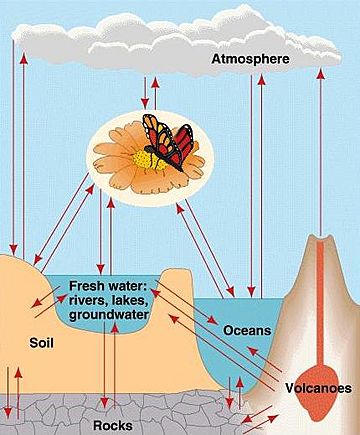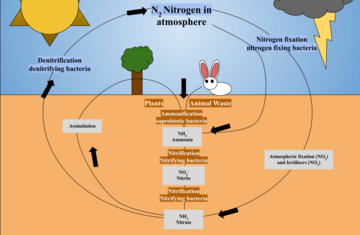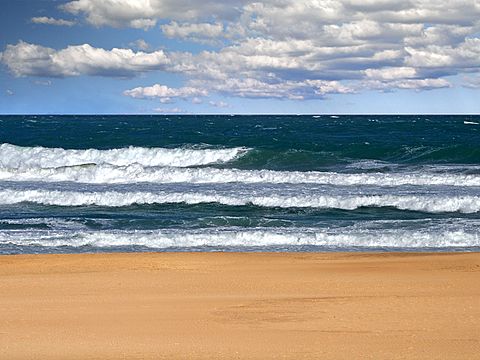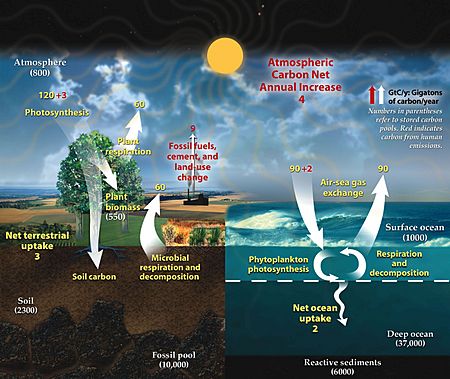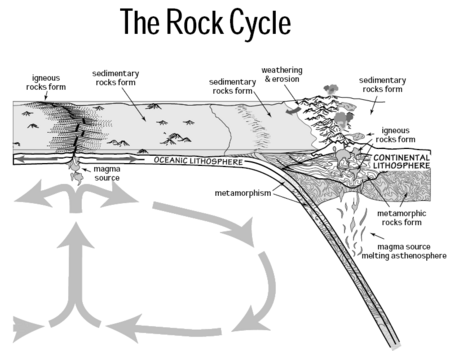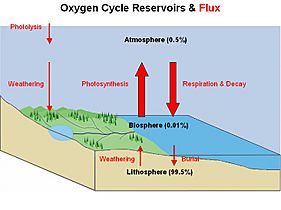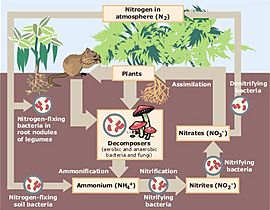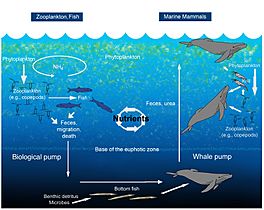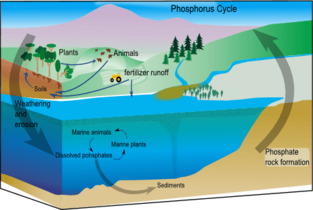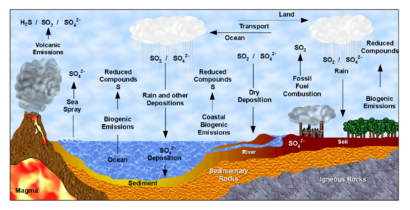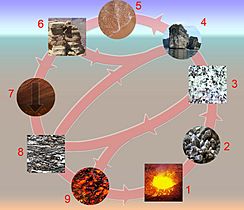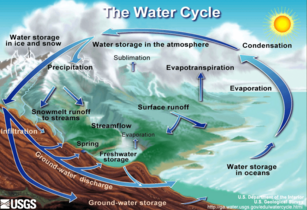Biogeochemical cycle facts for kids
Imagine how things like water, carbon, and nitrogen move around our planet. They go from living things to the air, land, and oceans, and then back again. This never-ending journey is called a biogeochemical cycle. It's also known as a cycle of matter.
Some of the most important biogeochemical cycles are the carbon cycle, the nitrogen cycle, and the water cycle. In each cycle, chemicals change forms and travel through living things, the air, soil, and oceans. It's like a path a chemical takes as it moves between the living parts (like plants and animals) and non-living parts (like air, water, and rocks) of Earth. The living part is called the biosphere. The non-living parts are the atmosphere (air), lithosphere (land), and hydrosphere (water).
For example, in the carbon cycle, plants take in carbon dioxide from the air. They use photosynthesis to turn it into food for themselves. Animals then eat plants, getting carbon. Carbon goes back into the air when living things breathe out or when they decompose. Carbon is also stored in fossil fuels deep underground. When humans burn these fuels, more carbon goes into the atmosphere.
In the nitrogen cycle, nitrogen gas from the air is changed by plants into forms they can use, like ammonia. Other living things then use these nitrogen compounds. Nitrogen returns to the air through different processes.
In the water cycle, water evaporates from land and oceans, forming clouds. Then it falls back to Earth as rain or snow. This water can soak into the ground, becoming groundwater. Or it can flow over the surface into lakes and rivers. Eventually, this water flows into the ocean, carrying dissolved materials with it.
There are also biogeochemical cycles for many other elements. These include oxygen, hydrogen, phosphorus, calcium, iron, sulfur, mercury, and selenium. There are also cycles for molecules like water and silica. Even rocks have a cycle, called the rock cycle. Humans have also created cycles for man-made chemicals like polychlorinated biphenyls (PCBs). In some cycles, chemicals can stay in one place, called a reservoir, for a very long time.
Biogeochemical cycles involve how living things, geology (Earth's structure), and chemistry all work together. Tiny living things called microorganisms are super important drivers of these cycles. They can perform many different chemical changes needed to move nutrients and chemicals around our planet. Without them, many of these processes wouldn't happen. This would greatly affect how land and ocean ecosystems work. Changes to these cycles can even impact human health. These cycles are all connected. They help control the climate, support the growth of plants and other organisms, and keep ecosystems healthy. Human activities, like burning fossil fuels or using too much fertilizer, can upset these cycles. This can lead to climate change, pollution, and other environmental problems.
Contents
How Cycles Work
Energy moves through ecosystems in one direction. It starts as sunlight and leaves as heat. But the matter that makes up living things is saved and reused. The six most common elements in living things are carbon, nitrogen, hydrogen, oxygen, phosphorus, and sulfur. They can take many forms and stay in the air, on land, in water, or underground for long periods.
Earth's processes, like rocks breaking down (weathering), soil washing away (erosion), and water flowing, all help recycle these materials. Because geology and chemistry are so important in this process, we call it a biogeochemical cycle.
These six elements are used by living things in many ways. Hydrogen and oxygen are found in water and other important molecules needed for life. Carbon is in all living molecules. Nitrogen is a key part of nucleic acids (like DNA) and proteins. Phosphorus helps make nucleic acids and parts of cell membranes. Sulfur is important for the shape of proteins.
The cycling of these elements is connected. For example, water helps carry sulfur and phosphorus into rivers and then into oceans. Minerals move through the living and non-living parts of the Earth, and from one organism to another.
Every ecosystem has many biogeochemical cycles happening at the same time. Examples include the water cycle, carbon cycle, and nitrogen cycle. All chemical elements found in living things are part of these cycles. Besides being in living organisms, these chemicals also move through the non-living parts of ecosystems. These non-living parts are water (hydrosphere), land (lithosphere), and air (atmosphere).
All the nutrients, like carbon, nitrogen, oxygen, phosphorus, and sulfur, used by living things are part of a closed system. This means these chemicals are recycled over and over. They are not lost and constantly replaced, like in an open system.
The main parts of the biosphere are linked by the flow of chemical elements and compounds in these cycles. Living things play a big role in many of these cycles. Matter from deep inside the Earth can be released by volcanoes. The atmosphere quickly exchanges some compounds and elements with living things and the oceans. Exchanges of materials between rocks, soils, and the oceans are usually much slower.
The flow of energy in an ecosystem is an open system. The sun constantly gives Earth energy as light. This energy is eventually used and lost as heat as it moves through the food web. Carbon is used to make carbohydrates, fats, and proteins, which are major sources of energy for food. These compounds are broken down to release carbon dioxide. Plants can then capture this carbon dioxide to make new organic compounds. This chemical process is powered by sunlight.
Even in the deep sea, where no sunlight reaches, ecosystems get energy from sulfur. Organisms near hot vents on the seafloor can use hydrogen sulfide for energy. In the sulfur cycle, sulfur can be recycled forever as an energy source. Energy can be released by changing sulfur compounds.
Earth's Compartments
The Earth has different "compartments" where these cycles take place:
- Atmosphere: This is the air around our planet.
- Hydrosphere: This includes all the water on Earth, like oceans, lakes, and rivers.
- Lithosphere: This is the solid part of Earth, including rocks and soil.
- Biosphere: This includes all living things on Earth.
The global ocean covers more than 70% of Earth. It's very diverse. Productive ocean areas and coastal ecosystems are a small part of the ocean. But they have a huge impact on global biogeochemical cycles. Tiny living things called microbial communities do most of this work. They make up 90% of the ocean's living matter.
Humans are greatly affecting these marine areas. For example, farm runoff can add too much nitrogen and phosphorus to coastal waters. This causes huge algal blooms. These blooms can lead to less oxygen in the water and more greenhouse gases. This directly impacts the nitrogen and carbon cycles. Climate change is also causing glaciers and permafrost to melt. This changes how water layers in the ocean, affecting microbial life.
These changes are impacting key processes like how much food is produced in the ocean. They also affect how carbon dioxide and nitrogen are used, how organic matter breaks down, and how carbon sinks to the seafloor. The oceans are also becoming more acidic. This affects tiny organisms that build shells.
Reservoirs
Chemicals sometimes stay in one place for a long time. This place is called a reservoir. For example, coal deposits store carbon for millions of years. When chemicals are held for only short periods, they are in exchange pools. Plants and animals are examples of exchange pools.
Plants and animals use carbon to make carbohydrates, fats, and proteins. These are used to build their bodies or get energy. Plants and animals use carbon for a short time. Then they release it back into the air or water. Generally, reservoirs are non-living parts of the Earth, while exchange pools are living parts. Carbon stays in plants and animals for a much shorter time compared to coal deposits. The time a chemical stays in one place is called its residence time.
Fast and Slow Cycles
There are fast and slow biogeochemical cycles. Fast cycles happen in the biosphere (living things). They can finish within years. They move substances from the air to living things, then back to the air. Slow cycles happen in rocks. They can take millions of years to complete. They move substances through Earth's crust between rocks, soil, ocean, and air.
For example, the fast carbon cycle involves quick processes between the environment and living organisms. This includes carbon moving between the air, land, and ocean ecosystems. It also includes carbon in soils and seafloor sediments. The fast cycle includes yearly changes like photosynthesis and longer changes like plant growth and decay. How the fast carbon cycle reacts to human activities will show many of the immediate effects of climate change.
The slow cycle involves longer-term geological processes, part of the rock cycle. Carbon exchange between the ocean and air can take hundreds of years. Rocks breaking down can take millions of years. Carbon in the ocean can settle to the seafloor and form sedimentary rock. This rock can then be pulled deep into the Earth. When mountains form, this geological carbon can return to the Earth's surface. There, rocks break down, and carbon returns to the air or oceans. Volcanoes also release geological carbon directly into the air as carbon dioxide. However, this is less than one percent of the carbon dioxide humans put into the air by burning fossil fuels.
Examples of Cycles
Here are some of the most well-known biogeochemical cycles:
Many biogeochemical cycles are being studied for the first time right now. Climate change and human impacts are greatly changing how fast, how strongly, and how balanced these less-known cycles are. These include:
- the mercury cycle, and
- the human-caused cycle of PCBs.
-
Chloroplasts help plants make food through photosynthesis.
Biogeochemical cycles always involve a balance in how elements move between different parts of the Earth. This balance can happen on a global scale.
Because biogeochemical cycles describe how substances move all over the world, studying them involves many different subjects. The carbon cycle, for example, is linked to ecology (the study of living things and their environment) and atmospheric sciences (the study of the air). How chemicals move is also related to geology (the study of Earth's rocks) and pedology (the study of soil).
Images for kids
See also
 In Spanish: Ciclo biogeoquímico para niños
In Spanish: Ciclo biogeoquímico para niños
- Carbonate–silicate cycle
- Ecological recycling
- Great Acceleration
- Hydrogen cycle
- Redox gradient


